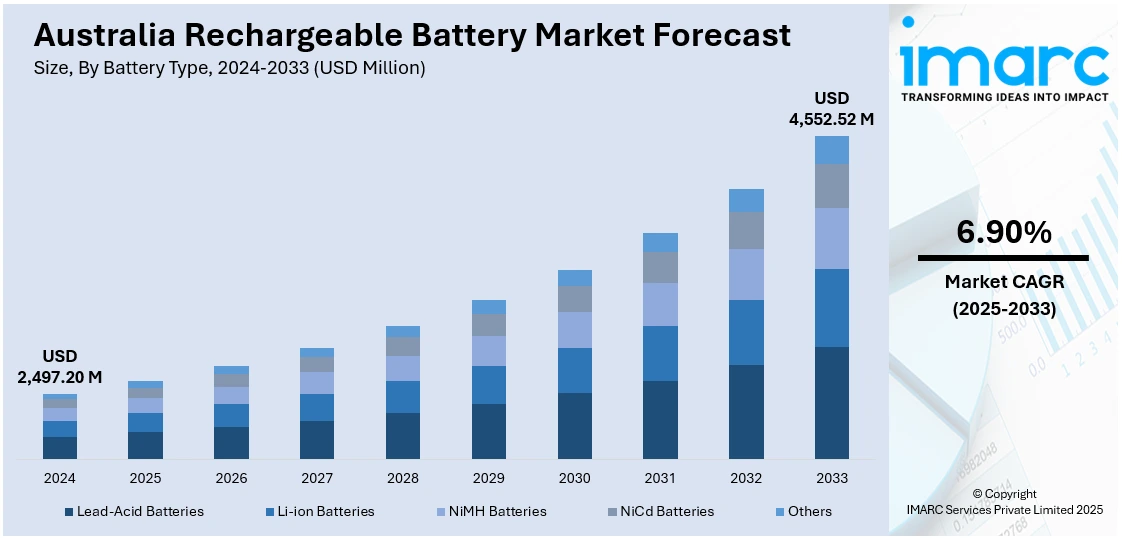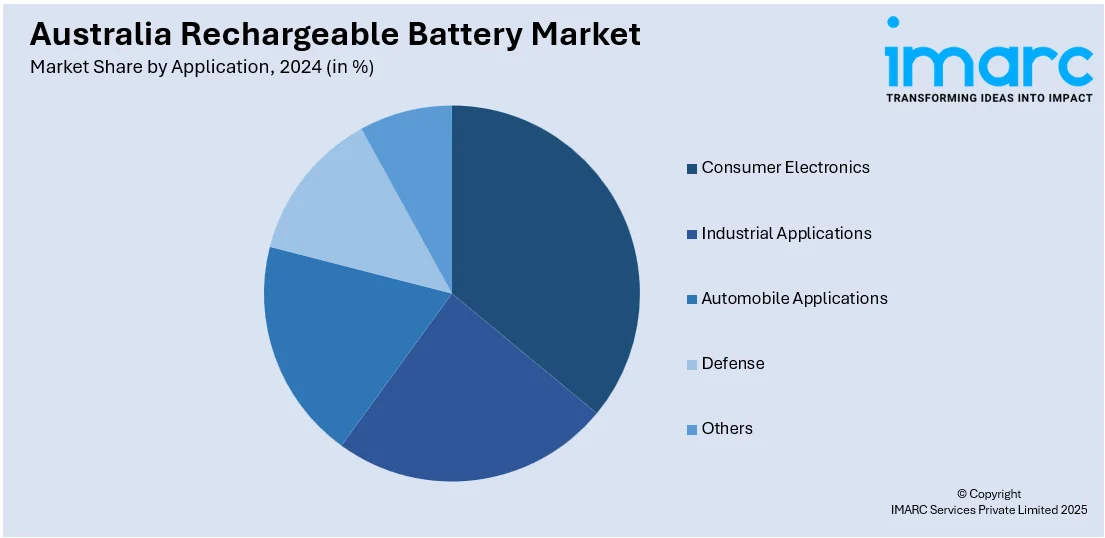
Australia Rechargeable Battery Market Size, Share, Trends and Forecast by Battery Type, Capacity, Application, and Region, 2025-2033
Australia Rechargeable Battery Market Overview:
The Australia rechargeable battery market size reached USD 2,497.20 Million in 2024. Looking forward, IMARC Group expects the market to reach USD 4,552.52 Million by 2033, exhibiting a growth rate (CAGR) of 6.90% during 2025-2033. The market in Australia is expanding, driven by the growing awareness about long-term benefits of electric vehicle (EV) ownership, along with advancements in technology, which aid in improving energy density and battery lifespan.
|
Report Attribute
|
Key Statistics
|
|---|---|
|
Base Year
|
2024
|
|
Forecast Years
|
2025-2033
|
|
Historical Years
|
2019-2024
|
| Market Size in 2024 | USD 2,497.20 Million |
| Market Forecast in 2033 | USD 4,552.52 Million |
| Market Growth Rate 2025-2033 | 6.90% |
Australia Rechargeable Battery Market Trends:
Increasing adoption of EVs
The rising adoption of EVs is fueling the market growth. According to the Federal Chamber of Automotive Industries and EV Council, Australians purchased a total of 91,292 new EVs in 2024. With environmental concerns rising, EVs are emerging as a cleaner alternative to fossil-fuel-powered vehicles. Their increasing popularity is driving the demand for advanced rechargeable batteries. The government is supporting this shift through incentives, subsidies, and policies aimed at reducing carbon emissions, further encouraging EV purchases. As the number of EVs is increasing, the need for efficient, high-capacity, and durable batteries is becoming critical. Battery manufacturers are investing in innovations to improve performance, minimize charging time, and extend lifespan, catering to the evolving needs of the EV sector. Apart from this, the public and private sectors are wagering on expanding charging infrastructure. Additionally, Australia’s growing focus on renewable energy aligns with the use of EVs and rechargeable batteries, integrating them into the broader energy ecosystem. The rising awareness among the masses about fuel savings and long-term benefits of EV ownership is also catalyzing rechargeable battery demand. Automakers are collaborating with battery producers to ensure a steady supply of quality batteries, fostering a robust supply chain.

To get more information on this market, Request Sample
Advancements in technology
Advancements in technology are offering a favorable Australia rechargeable battery market outlook. With ongoing innovations, modern rechargeable batteries are becoming more compact, efficient, and environment friendly, catering to the rising demand from industries, such as electronics, automotive, and renewable energy. Enhanced battery management systems and smart charging capabilities allow safer and more reliable performance, which boosts user confidence and broadens market appeal. Investments in lithium-ion battery anode technology play a key role in increasing energy storage capacity and reducing charging time, further fueling the market growth. In October 2024, the Australian Renewable Energy Agency (ARENA) dedicated nearly USD 4 Million in funding to the Australian tech firm AnteoTech Ltd to bring its innovative lithium-ion battery anode technology to market. The USD 11.1 Million project titled ‘Silicon Anode Technology for Lithium-Ion Batteries’ would last for three years, targeting the commercialization of AnteoTech’s unique silicon anode technology, lowering battery storage expenses, and facilitating extended driving ranges for EVs. Apart from this, the development of solid-state batteries, advanced thermal management systems, and recyclable materials is supporting sustainability goals and encouraging adoption across various sectors.
Australia Rechargeable Battery Market Segmentation:
IMARC Group provides an analysis of the key trends in each segment of the market, along with forecasts at the country and regional levels for 2025-2033. Our report has categorized the market based on battery type, capacity, and application.
Battery Type Insights:
- Lead-Acid Batteries
- Li-ion Batteries
- NiMH Batteries
- NiCd Batteries
- Others
The report has provided a detailed breakup and analysis of the market based on the battery type. This includes lead-acid batteries, Li-ion batteries, NiMH batteries, NiCd batteries, and others.
Capacity Insights:
- 150 - 1000 mAh
- 1300 - 2700 mAh
- 3000 - 4000 mAh
- 4000 - 6000 mAh
- 6000 - 10000 mAh
- More than 10000 mAh
A detailed breakup and analysis of the market based on the capacity have also been provided in the report. This includes 150 - 1000 mAh, 1300 - 2700 mAh, 3000 - 4000 mAh, 4000 - 6000 mAh, 6000 - 10000 mAh, and more than 10000 mAh.
Application Insights:

- Consumer Electronics
- Industrial Applications
- Automobile Applications
- Defense
- Others
The report has provided a detailed breakup and analysis of the market based on the application. This includes consumer electronics, industrial applications, automobile applications, defense, and others.
Regional Insights:
- Australia Capital Territory & New South Wales
- Victoria & Tasmania
- Queensland
- Northern Territory & Southern Australia
- Western Australia
The report has also provided a comprehensive analysis of all the major regional markets, which include Australia Capital Territory & New South Wales, Victoria & Tasmania, Queensland, Northern Territory & Southern Australia, and Western Australia.
Competitive Landscape:
The market research report has also provided a comprehensive analysis of the competitive landscape. Competitive analysis such as market structure, key player positioning, top winning strategies, competitive dashboard, and company evaluation quadrant has been covered in the report. Also, detailed profiles of all major companies have been provided.
Australia Rechargeable Battery Market News:
- In March 2025, BYD introduced super-fast 1 megawatt EV charging in Australia. The firm claimed that this technology allowed a drained battery to achieve a 600 KM driving range with just a five-minute recharge, providing 2 KM of range every second. The automobile manufacturer also revealed plans to launch its next-generation Blade 2 lithium-ion phosphate (LFP) batteries, offering up to 1000 KM on a single charge, facilitating a smooth trip from Sydney to Melbourne.
- In November 2024, ChargeCore, a subsidiary of prominent Australian consumer technology firm LASER, unveiled ReChargeCore Batteries. These cutting-edge rechargeable batteries provided an eco-friendly and economical option compared to standard alkaline batteries. They came in AA and AAA sizes, meeting the typical requirements of households. Fitted with a USB-C port, they could be easily recharged in only 90 minutes, removing the requirement for a separate battery charger.
Australia Rechargeable Battery Market Report Coverage:
| Report Features | Details |
|---|---|
| Base Year of the Analysis | 2024 |
| Historical Period | 2019-2024 |
| Forecast Period | 2025-2033 |
| Units | Million USD |
| Scope of the Report |
Exploration of Historical Trends and Market Outlook, Industry Catalysts and Challenges, Segment-Wise Historical and Future Market Assessment:
|
| Battery Types Covered | Lead-Acid Batteries, Li-ion Batteries, NiMH Batteries, NiCd Batteries, Others |
| Capacities Covered | 150 - 1000 mAh, 1300 - 2700 mAh, 3000 - 4000 mAh, 4000 - 6000 mAh, 6000 - 10000 mAh, More than 10000 mAh |
| Applications Covered | Consumer Electronics, Industrial Applications, Automobile Applications, Defence, Others |
| Regions Covered | Australia Capital Territory & New South Wales, Victoria & Tasmania, Queensland, Northern Territory & Southern Australia, Western Australia |
| Customization Scope | 10% Free Customization |
| Post-Sale Analyst Support | 10-12 Weeks |
| Delivery Format | PDF and Excel through Email (We can also provide the editable version of the report in PPT/Word format on special request) |
Key Questions Answered in This Report:
- How has the Australia rechargeable battery market performed so far and how will it perform in the coming years?
- What is the breakup of the Australia rechargeable battery market on the basis of battery type?
- What is the breakup of the Australia rechargeable battery market on the basis of capacity?
- What is the breakup of the Australia rechargeable battery market on the basis of application?
- What is the breakup of the Australia rechargeable battery market on the basis of region?
- What are the various stages in the value chain of the Australia rechargeable battery market?
- What are the key driving factors and challenges in the Australia rechargeable battery?
- What is the structure of the Australia rechargeable battery market and who are the key players?
- What is the degree of competition in the Australia rechargeable battery market?
Key Benefits for Stakeholders:
- IMARC’s industry report offers a comprehensive quantitative analysis of various market segments, historical and current market trends, the Australia rechargeable battery market forecast, and dynamics from 2019-2033.
- The research report provides the latest information on the market drivers, challenges, and opportunities in the Australia rechargeable battery market.
- Porter's five forces analysis assist stakeholders in assessing the impact of new entrants, competitive rivalry, supplier power, buyer power, and the threat of substitution. It helps stakeholders to analyze the level of competition within the Australia rechargeable battery industry and its attractiveness.
- Competitive landscape allows stakeholders to understand their competitive environment and provides an insight into the current positions of key players in the market.
Need more help?
- Speak to our experienced analysts for insights on the current market scenarios.
- Include additional segments and countries to customize the report as per your requirement.
- Gain an unparalleled competitive advantage in your domain by understanding how to utilize the report and positively impacting your operations and revenue.
- For further assistance, please connect with our analysts.
 Request Customization
Request Customization
 Speak to an Analyst
Speak to an Analyst
 Request Brochure
Request Brochure
 Inquire Before Buying
Inquire Before Buying




.webp)




.webp)












